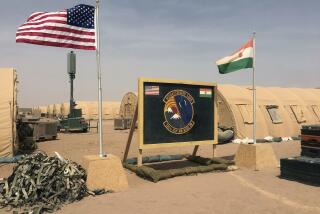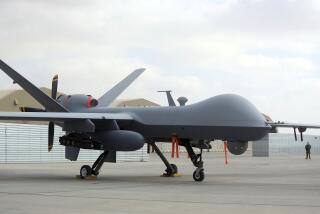U.S. continues airstrikes in Libya
American warplanes have bombed three ground targets in Libya since the Obama administration announced this month that the United States was shifting to a support role in the NATO-led air campaign, the Pentagon acknowledged.
Marine Col. Dave Lapan, a Pentagon spokesman, said Wednesday that U.S. fighter jets have attacked Libyan air defense sites to support the no-fly zone imposed last month under a United Nations mandate to deter attacks against civilians by forces loyal to Libyan leader Moammar Kadafi.
Administration officials previously said the U.S. had halted strike sorties on April 4, several days after turning over command of the air campaign to the NATO alliance, and that attacks on Libyan tanks and other ground units would be handled by Britain, France and other allies.
But the limited U.S. role has grown increasingly controversial.
Libyan opposition leaders and some NATO allies publicly complained about the intensity and scope of the air campaign against Kadafi’s forces since the U.S. announced that American warplanes would end their participation.
In a speech last month announcing the hand-over to a non-U.S. NATO commander, President Obama said that “the United States will play a supporting role, including intelligence, logistical support, search-and-rescue assistance, and capabilities to jam regime communications.”
A senior U.S. military official said that three attacks were launched last week against Libyan surface-to-air missile sites. U.S. F-16 fighters and EA-18G jamming aircraft carried out the strikes with 500-pound bombs.
Defense Department officials disputed suggestions that the attacks contradicted administration claims to have moved to a supporting role in the operations. Lapan said the U.S. combat role was confined to enforcing the no-fly zone and that non-American warplanes were attacking Libyan military units that threatened civilians.
Pentagon Press Secretary Geoff S. Morrell called the bombing of the three air defense sites a “defensive” action to prevent Libyan air defense units from attacking NATO warplanes.
But the Pentagon also appeared eager Wednesday to counter the impression that the U.S. had withdrawn completely from an active role in the air campaign.
Of the 134 missions to monitor Libyan air defense sites since NATO took command, 97 have been flown by U.S. aircraft.
Since April 1, U.S. aircraft have carried out 35% of the sorties, 77% of the aerial refueling missions and 27% of the surveillance flights, Lapan said.
U.S. officials have said that other fighters and ground attack planes remain available to NATO, but that Defense Secretary Robert M. Gates would have to approve any request to use them to attack ground forces. No such requests have been received, Lapan said.
More to Read
Sign up for Essential California
The most important California stories and recommendations in your inbox every morning.
You may occasionally receive promotional content from the Los Angeles Times.











